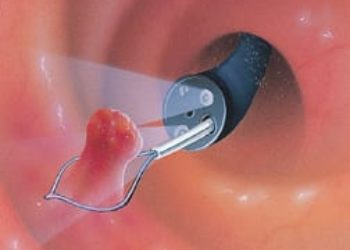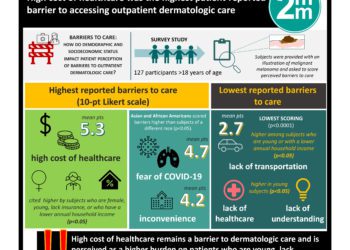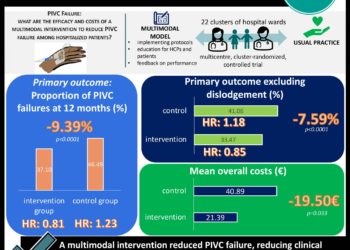Standardized cost-effective model for diagnosing and treating febrile infants [Pediatrics Classics Series]
Image: PD
1. Following implementation of an evidence-based care process model for evaluation and treatment of febrile infants, children were found to have significantly shorter hospital stays, reduced risk of a missed serious bacterial infection, and underwent significantly more laboratory testing. Despite this increase in testing, hospital costs decreased significantly over the study course.
Original Date of Publication: July 2012
Study Rundown: With nearly 10% of all infants experiencing a potentially life-threatening, serious bacterial infection ([SBI], including bacteremia, meningitis, or urinary tract infection [UTI]), it is necessary to assure effective and efficient care for those at risk. At the time of this study and into today, the evaluation of fever in infants 1 to 90 days of age was not, and still is not, standardized. In order to target the care of febrile infants, researchers in this study designed an evidence-based care process model (EB-CPM) for the care of well-appearing febrile infants in the first 90 days of life with a goal to decrease variation and improve the quality of care provided to infants treated in regional and tertiary medical centers in Utah. The EB-CPM was implemented in January of 2008 with each involved facility receiving monthly feedback. Outcomes investigated included the modifications in care delivered, clinical outcomes of febrile infants treated in the model, and changes in cost associated with EB-CPM implementation. In total, 8431 febrile episodes were investigated. Researchers found that following EB-CPM implementation as documented below, significant increases in UTI and SBI admissions were noted. Although the length of hospital stay (LOS) decreased significantly, no SBI cases were missed following EB-CPM use. Also, while infants underwent more laboratory testing, total costs decreased significantly—an estimated $1.9 million in savings was attributed to the EB-CPM. Overall, with the increased detection of SBI, appropriate treatment according to the protocol, and resultant decrease in missed SBI and readmissions rates, the implementation was deemed successful. This study was limited by EB-CPM application to a single healthcare system and a lack of training evaluation; however, the study was strengthened by its large febrile cohort and implementation of the model in a system with multiple different practices and settings. This relatively recent study indicated that successful implementation of a practice model for the care of febrile infants was possible and had the potential to produce meaningful positive outcomes. The national or worldwide adoption of other practice models for the management of both simple and challenging medical problems is recognized as a possible mechanism for creating healthcare changes on a large scale.
Click to read the study in Pediatrics
In-Depth [observational study]: The EB-CPM was implemented through Utah’s Intermountain Healthcare system’s Intermountain Pediatric Clinical Program, where about 85% of Utah’s children receive care. The records for a total of 8431 febrile episodes in 8044 infants treated at target sites were included in the analyses. SBI was defined as bacteremia, meningitis, or UTI (further defined as > 50000 colony forming units/mL of a single pathogen) confirmed by culture. A “missed SBI” was identified in infants who were treated in the emergency department (ED) or hospital and then returned to the ED within 5 days with confirmed SBI requiring treatment. The EB-CPM includes the following recommendations: all febrile infants should undergo a standard history and physical examination, CBC, and urinalysis (UA). Infants considered “high risk” (infants < 28 days old, infants born at < 37 weeks gestation, those with chronic medical conditions, < 5000 or >15000 WBCs/mm3 on CBC, > 10 WBCs/high power field on UA) were classified based off of a modification of the “Rochester Criteria,” a previously published set of guidelines for determining those at higher risk for an SBI.1 For infants who were not “high risk,” the administration of antibiotics was not encouraged, while for those identified as “high risk” admission and the administration of antibiotics were recommended. Infants admitted to the hospital were recommended to undergo viral diagnostic testing including enterovirus testing from June to November or if cerebrospinal pleocytosis was present. After 24 hours, it was recommended that culture-negative “high risk” admitted patients who tested positive for a viral pathogen and infants at low-risk for SBI be discharged and antibiotics discontinued. All infants falling into other categories were recommended for discharge at 36 hours. Quality measures were assessed during the initiation time period (July 1, 2004 to December 31, 2007) and later implementation of the EB-CPM (January 1, 2008 to December 31, 2009). Linear models and logistic regression analysis were used to compare performance over the study period. Cost was assessed through an accounting program and adjusted appropriately for inflation.
Of the 8431 episodes analyzed (mean age of infants = 45 days, 54% male, 62% white), 735 (9%) had confirmed SBI (617 UTI, 172 bacteremia, and 23 meningitis, NOTE: a smaller number of children having a combination of at these entities). A total of 5444 febrile episodes occurred during the “base and training” portion of the study and another 2987 presented during the implementation phase of the study. With regard to laboratory testing, significant increases in CBC, UA, blood cultures, urine cultures, and viral testing were observed (P < 0.001 for all). No increase in lumbar puncture was noted. Significantly higher proportions of patients were diagnosed with UTI (9% v. 7%, P < 0.001), admitted with SBI (16% v. 13%, P< 0.05), and were diagnosed with viruses (25% v. 30%, P < 0.001) following EB-CPM implementation when compared to the training period. No cases of SBI were missed during the implementation portion of the study, while 68 “missed SBIs” were detected during the training period. Infants classified as “high risk” were significantly more likely to receive antibiotics following EB-CPM implementation when compared to those at low risk (85% v. 63%, P < 0.001) and low risk infants were significantly less likely to receive antibiotics following implementations in both the inpatient and outpatient settings (P < 0.01). Hospital LOS decreased significantly across all hospitals (P < 0.01) following implementation without any increase in readmissions. In examining costs, there were significant increases in spending from the ED ($184 v. $153, P < 0.001); however, costs decreased significantly among those admitted to regional medical centers ($8037 v. $6202 per admitted infant, P < 0.001) and by 11.6% at the major tertiary care center in Utah (P < 0.001). It is predicted that an estimated $1.9 million were saved as a resulted of the EB-CPM implementation.
© 2012-2014 2minutemedicine.com. All rights reserved. No works may be reproduced without expressed written consent from 2minutemedicine.com. Disclaimer: We present factual information directly from peer reviewed medical journals. No post should be construed as medical advice and is not intended as such by the authors, editors, staff or by 2minutemedicine.com. PLEASE SEE A HEALTHCARE PROVIDER IN YOUR AREA IF YOU SEEK MEDICAL ADVICE OF ANY SORT.









